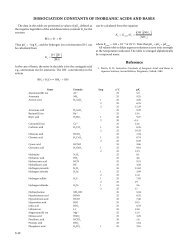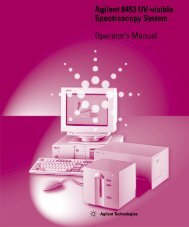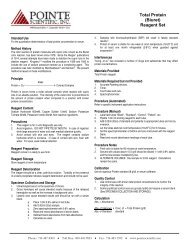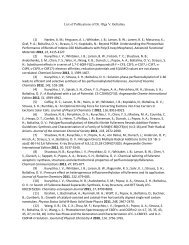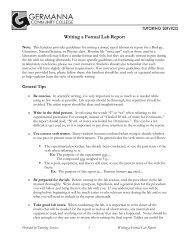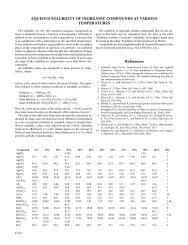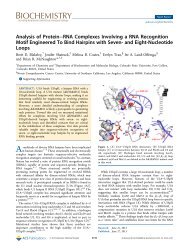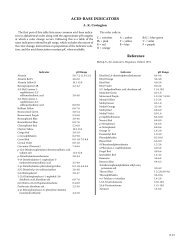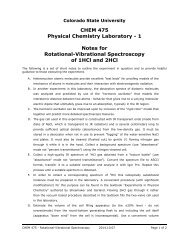Calibration of Volumetric Glassware - Colorado State University
Calibration of Volumetric Glassware - Colorado State University
Calibration of Volumetric Glassware - Colorado State University
Create successful ePaper yourself
Turn your PDF publications into a flip-book with our unique Google optimized e-Paper software.
<strong>Calibration</strong> <strong>of</strong> <strong>Volumetric</strong> <strong>Glassware</strong> CHEM 334 Quantitative Analysis Laboratory Measuring Pipette. Fill a 10 mL measuring pipette with deionized water, then drain it to ensure that no droplets remain on the inner walls. If droplets remain, clean the pipette thoroughly and repeat. Fill the pipette and deliver approximately two milliliters into the weighed bottle. Estimate all volume readings to the nearest 0.01 mL. Cap the bottle and reweigh. Repeat this procedure for samples <strong>of</strong> 4, 6 and 8 mL. Perform three replicate measurements for the pipette. Transfer Pipette. Fill a 10 mL transfer pipette with deionized water and drain to ensure that no droplets remain on the inner walls. If droplets remain, clean the pipette thoroughly and repeat. Fill the pipette to the fill line and deliver the total volume <strong>of</strong> liquid into a dry bottle. Cap the weighing bottle and reweigh. Perform three replicate measurements for the pipette. <strong>Volumetric</strong> Flask. Calibrate a 10 mL volumetric flask by weighing it empty (and dry) and filled to the mark with distilled water. Perform three replicate measurements for the flask. Results Transfer Pipette. Use the density <strong>of</strong> water to convert the mass <strong>of</strong> water to the volume delivered by your pipette. Determine the average and 95% confidence interval for the three replicate measurements for the pipette. If the 95% confidence intervals are greater than the tolerance for the 10 mL pipette and if time permits repeat these measurements. <strong>Volumetric</strong> Flask. Convert the mass <strong>of</strong> water contained in your volumetric flask to volume. Determine the average volume and 95% confidence interval. If time permits, repeat the calibration if the 95% confidence intervals greater than the tolerance for the 10 mL flask. In the future, use this average value as the exact volume contained in the flask. Measuring Pipette. Convert the mass <strong>of</strong> water to the volume delivered by the pipette. Plot the average measured volume obtained from your replicate measurements delivered versus the expected volume delivered as read on the pipette for the 10 mL pipette. Plot y-‐value error bars corresponding to the standard deviation obtained from your replicate measurements. (Can you see the error bars?) Using a linear regression analysis, determine the best-‐fit equation for the relationship between measured and expected volumes. Include both slope and intercept in the analysis. Report the slope, its standard deviation, the y-‐intercept, its standard deviation and the R 2 value <strong>of</strong> the calibration line. Calculate the 95% confidence interval for each value <strong>of</strong> expected volume. Discussion Prepare a Laboratory Report as described previously. Present all measured data in the report together with the expected data. Describe and explain the relationships between the two sets <strong>of</strong> data. Include good-‐quality figures and tables to substantiate your discussions. Include answers to the several "why?" questions that appear in this description. Include a quantitative error analysis in your discussion. Compare your assessment <strong>of</strong> the various volumetric glassware accuracy values to the manufacturer's stated values. References Tufte, E.R., "Envisioning Information" (1990), Graphic Press, CT, Chapters 1 and 6. <strong>Colorado</strong> <strong>State</strong> <strong>University</strong> 2014.09.08 Page 5 <strong>of</strong> 6




